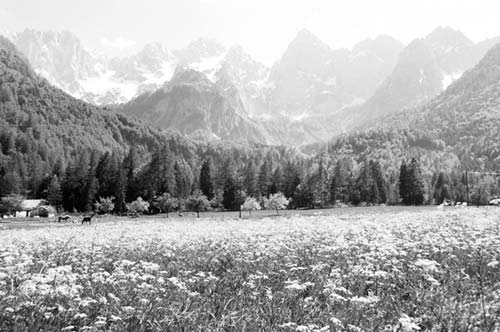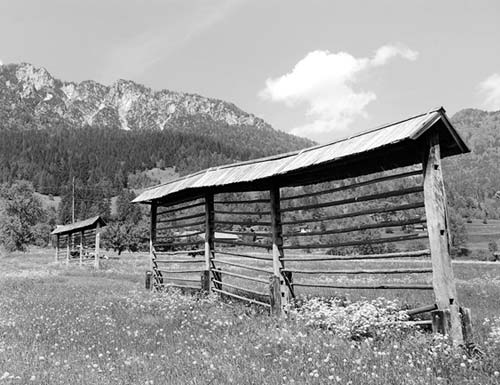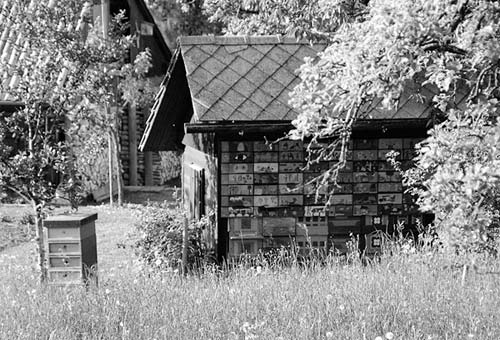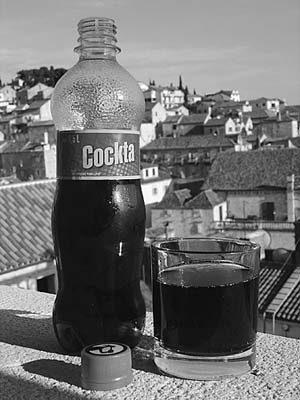Tiny, overlooked Slovenia is one of Europe’s most unexpectedly charming destinations. At the intersection of the Slavic, German, and Italian worlds, Slovenia is an exciting mix of the best of each culture. Though it’s just a quick trip away from the tourist throngs in Venice, Munich, Salzburg, and Vienna, Slovenia has stayed off the tourist track—making it a handy detour for in-the-know Back Door travelers. Be warned: Everyone I’ve met who has visited Slovenia wishes they’d allotted more time for this delightful, underrated land.
Today, it seems strange to think that Slovenia was ever part of Yugoslavia. Both in the personality of its people and in its landscape, Slovenia feels more like Austria. Slovenes are more industrious, organized, and punctual than their fellow former Yugoslavs...yet still friendly, relaxed, and Mediterranean. Locals like the balance. Visitors expecting minefields and rusting Yugo factories are pleasantly surprised to find Slovenia’s rolling countryside dotted instead with quaint alpine villages and the spires of miniature Baroque churches, with breathtaking, snowcapped peaks in the distance.

Only half as big as Switzerland, Slovenia is remarkably diverse for its size. Travelers can hike on alpine trails in the morning and explore some of the world’s best caves in the afternoon, before relaxing with a glass of local wine and a seafood dinner while watching the sun set on the Adriatic.
Though not unaffected by the recent economic crisis, Slovenia enjoys a prosperity unusual for a formerly communist country. The Austro-Hungarian Empire left it with a strong work ethic and an impressive industrial infrastructure, which the Yugoslav government expanded. By 1980, 60 percent of all Yugoslav industry was in little Slovenia (which had only 8 percent of Yugoslavia’s population and 8 percent of its territory). Of the 13 new nations that have joined the European Union since 2004, Slovenia was the only one rich enough to be a net donor (with a higher per-capita income than the average), and the first one to join the euro currency zone (it adopted the euro in January of 2007). Thanks to its long-standing ties to the West and can-do spirit, Slovenia already feels more “Western” than any other destination in this book.
The country has a funny way of making people fall in love with it. Slovenes are laid-back, easygoing, stylish, and fun. They won’t win any world wars (they’re too well-adjusted to even try)...but they’re exactly the type of people you’d love to chat with over a cup of coffee.
The Slovenian language is as mellow as the people. While Slovenes use Serb, German, and English curses in abundance, the worst they can say in their native tongue is, “May you be kicked by a horse.” For “Darn it!” they say, “Three hundred hairy bears!” In bad traffic, they might utter under their breath, “The street is white!”

Coming from such a small country, locals are proud of the few things that are distinctly Slovenian, such as the roofed hayrack. Foreigners think that Slovenes’ fascination with these hayracks is strange...until they visit and see them absolutely everywhere (especially in the northwest). Because of the frequent rainfall, the hayracks are covered by a roof that allows the hay to dry thoroughly. The most traditional kind is the toplar, consisting of two hayracks connected by one big roof. It looks like a skinny barn with open, fenced sides. Hay hangs on the sides to dry; firewood, carts, tractors, and other farm implements sit on the ground inside; and dried hay is stored in the loft above. But these wooden toplarji are firetraps, and a stray bolt of lightning can burn one down in a flash. So in recent years, more farmers are moving to single hayracks (enojni); these are still roofed, but have posts made of concrete, rather than wood. You’ll find postcards and miniature wooden models of both kinds of hayracks (a fun souvenir).
Another good (and uniquely Slovenian) memento is a creatively decorated front panel from a beehive (panjske končnice). Slovenia has a strong beekeeping tradition, and beekeepers believe that painting the fronts of the hives makes it easier for bees to find their way home. Replicas of these panels are available at gift shops all over the country. (For more on the panels and Slovenia’s beekeeping heritage, see here.)

Slovenia is also the land of polka. Slovenes claim that polka music was invented here, and singer/accordionist Slavko Avsenik—from the village of Begunje near Bled—cranks out popular oompah songs that make him bigger than the Beatles (and therefore, presumably, Jesus) in Germany. You’ll see the Avsenik ensemble and other oompah bands on Slovenian TV, where hokey Lawrence Welk-style shows are a local institution.
To really stretch your euros, try one of Slovenia’s more than 400 farmhouse B&Bs, called “tourist farms” (turistične kmetije). These are actual, working farms (often organic) that sell meals and/or rent rooms to tourists to help make ends meet. You can use a tourist farm as a home base to explore the entire country—remember, the farthest reaches of Slovenia are only a day trip away. A comfortable, hotelesque double with a private bathroom—plus a traditional Slovenian dinner and a hearty breakfast—costs as little as €50. Request a listing from the Slovenian Tourist Board (see here), or find information at www.slovenia.info.
Most visitors to Slovenia are, in my experience, completely charmed by the place. With all it has going for it, it’s hard to believe that Slovenia is not already overrun with tourists. Somehow, this little country continues to glide beneath the radar. Exploring its mountain trails, savoring its colorful capital, and meeting its friendly locals, you’ll feel like you’re in on a secret.
Sunday Closures: Slovenia can be extremely sleepy on Sundays, even in the larger towns and cities, where virtually all shops are closed. Plan ahead. Fortunately, many restaurants remain open, plus a select few grocery stores.
Smoking Ban: Smoking is prohibited in public places, unless it’s a specially designated (and well-ventilated) smoking room. Larger hotels still have some smoking rooms, but smoking isn’t allowed in public areas. Outdoors, all bets are off.
Telephones: Slovenian phone numbers beginning with 080 are toll-free; 090 and 089 denote expensive toll lines. Most mobile phone numbers begin with 03, 04, 05, or 07. For more details on how to dial to, from, and within Slovenia, see here.
Toll Sticker: To drive on Slovenia’s expressways (avtocesta), you’ll need to display a toll sticker (vinjeta, veen-YEH-tah; €15/week, €30/month). If renting your car in Slovenia, it probably comes with a toll sticker (but ask just to be sure); if you’re driving in from elsewhere, such as Croatia, you can buy one at a gas station, post office, or some newsstands (watch for vinjeta signs at gas stations as you approach the border). Be warned: This rule is taken very seriously. If you’re found driving on expressways without the sticker, you’ll immediately be fined €150.
Cruise Port: The Slovenian coastal town of Koper (see here) is becoming a popular port of call for Mediterranean cruises. As the country is so small, it’s possible to see just about any of the Slovenia destinations covered in this book in a single day in port (provided you use your time efficiently and have a private driver—I recommend Tina Hiti and Sašo Golub, listed on here).
Slovenia has a long and unexciting history as part of various larger empires. After Illyrian, Celtic, and Roman settlements came and went, this region became populated by Slavs—the ancestors of today’s Slovenes—in the late sixth century. But Charlemagne’s Franks conquered the tiny land in the eighth century, and, ever since, Slovenia has been a backwater of the Germanic world—first as a holding of the Holy Roman Empire and later, the Habsburg Empire. Slovenia seems as much German as Slavic. But even as the capital, Ljubljana, was populated by Austrians (and called Laibach by its German-speaking residents), the Slovenian language and cultural traditions survived in the countryside.
Through the Middle Ages, much of Slovenia was ruled by the Counts of Celje (highly placed vassals of the Habsburgs). In this era before modern nations—when shifting allegiances and strategic marriages dictated the dynamics of power—the Counts of Celje rose to a position of significant influence in Central and Eastern Europe. Celje daughters intermarried with some of the most powerful dynasties in the region—the Polish Piasts, the Hungarian Anjous, and the Czech Přemysls. Before long, the Counts of Celje had emerged as the Habsburgs’ main rivals.
In the 15th century, Count Ulrich II of Celje married into Serbia’s ruling family and managed to wrest control of Hungary’s massive holdings. Had he not been assassinated in 1456, this obscure Slovenian line—rather than an obscure Austrian one—may have emerged as the dominant power in the eastern half of Europe. (Instead, the Habsburgs consolidated their vanquished foe’s fiefdoms into their ever-growing empire.) In homage, the three yellow stars of the Counts of Celje’s seal still adorn Slovenia’s coat of arms.
Soon after, with Slovenia firmly entrenched in the Counter-Reformation holdings of the Habsburg Empire, the local Reformer Primož Trubar (1508-1586) strove both to put the Word of God into the people’s hands, and to legitimize Slovene as a written language. This Slovenian answer to Martin Luther secretly translated the Bible into Slovene in Reformation-friendly Germany, then smuggled copies back into his homeland.
Over the next several centuries, much of Slovenia was wracked by Habsburg-Ottoman wars, as the Ottomans attempted to push north through this territory to reach Vienna. Slovenia also found itself at the crossroads between Austria and Venice; many of their violent clashes took place here. Seemingly exhausted by all of this warfare—and by their own sporadic, halfhearted, and unsuccessful uprisings against Habsburg rule—Slovenia languished as a sleepy backwater.
When the port city of Trieste (in Slovenian territory) was granted free status in 1718, it boosted the economy of Slovenian lands. The Enlightenment spurred a renewed interest in the Slovenian culture and language, which further flourished when Napoleon named Ljubljana the capital of his “Illyrian Provinces”—Slovenia’s own mini-empire, stretching from Austria’s Tirol to Croatia’s Dalmatian Coast. During this brief period (1809-1813), the long-suppressed Slovene language was used for the first time in schools and the government. This kicked off a full-throated national revival movement (as in so many other Central and Eastern European countries at the time)—asserting the worthiness of the Slovenian language and culture compared to the dominant Germanic worldview of the time. Inspired by the patriotic poetry of France Prešeren (1800-1849), Slovenian pride surged.
The last century saw the most interesting chapter of Slovenian history. Some of World War I’s fiercest fighting occurred at the Soča (Isonzo) Front in northwest Slovenia—witnessed by young Ernest Hemingway, who drove an ambulance (see sidebars on here and here). During World War II, Slovenia was divided among Nazi allies Austria, Italy, and Hungary—and an estimated 20,000 to 25,000 Slovenes perished in Nazi- and Italian-operated concentration camps.
As Yugoslavia entered its Golden Age under war hero Marshal Tito, Slovenia’s prime location where Yugoslavia meets Western Europe (a short drive from Austria or Italy)—and the diligent national character of the Slovenian people—made it a prime candidate for industrialization.
After Tito’s death in 1980, the various Yugoslav republics struggled to redefine their role in the union. While many factions reverted to age-old, pre-Tito nationalistic fervor, the Slovenes grew increasingly focused on their own future...and began to press for real reforms of the communist system. Slovenia had always been Yugoslavia’s smallest, northernmost, most prosperous republic. Slovenes now realize that Yugoslavia needed Slovenia much more than Slovenia needed Yugoslavia.
In 1988, the iconoclastic Slovenian magazine Mladina pressed the boundaries of Yugoslavia’s nominally “free” press, publishing articles critical of the Yugoslav People’s Army. Four young reporters (including Janez Janša, who would later become Slovenia’s prime minister) were tried, convicted, and imprisoned, spurring outrage among Slovenes. A few months later, the Slovenian delegation defiantly walked out of the Yugoslav League of Communists Congress. The first-ever free elections in Slovenia on April 8, 1990, ended communist rule and swept reformer Milan Kučan into the presidency. Kučan attempted to pursue a Swiss-style confederated relationship with his fellow Yugoslav republics, but met with resistance from his counterparts who were more focused on their own ethnic self-interests. Later that year, in a nationwide referendum, 88 percent of Slovenes voted for independence from Yugoslavia.
And so, concerned about Serbian strongman Slobodan Milošević’s nationalistic politics, and seeking the opportunity for true democracy and capitalism, Slovenia seceded in 1991. Because more than 90 percent of the people here were ethnic Slovenes—and because Slovenia was careful to respect the rights of its minority populations—the break with Yugoslavia was simple and virtually uncontested. Its war for independence lasted just 10 days and claimed only a few dozen lives. (For more details, see here in the Understanding Yugoslavia chapter.)
After centuries of looking to the West, in May of 2004 Slovenia became the first of the former Yugoslav republics to join the European Union. The Slovenes have been practical about this move, realizing it’s essential for their survival as a tiny nation in a modern world. But there are trade-offs, and “Euroskeptics” are down on EU bureaucracy. As borders disappear, Slovenes are experiencing more crime. Traditional farms are grappling with strict EU standards. Slovenian businesses are having difficulty competing with big German and other Western European firms. Before EU membership, only Slovenes could own Slovenian land, but now wealthy foreigners are buying property, driving up the cost of real estate. Still, overall, most Slovenes feel that EU membership was the right choice.
After independence, Slovenia impressed its European neighbors with its powerhouse economy and steady growth. However, the global financial crisis revealed that some of the country’s affluence was deceptive; it turned out that many of Slovenia’s biggest companies had been financing their operations by running up huge debts (not unlike individuals committing to a mortgage they’d never be able to afford). As all of Europe’s bubble burst in 2008, those corporate debts were assumed by Slovenia’s big banks—devastating the economy and sparking even more financial worries here than in many other countries.
After visionary Ljubljana mayor Zoran Janković (see here) failed to create a ruling coalition in the 2011 parliamentary elections, his rival Janez Janša became prime minister. Then, in the winter of 2012-2013, a massive wave of protests swept the country. Slovenes were outraged at the austerity measures proposed by the same government officials whose alleged corruption had worsened their economic straits. Economists began to speculate that Slovenia might need to ask for a Greece-style bailout from the EU to rescue its flagging economy. Janša was forced from office, succeeded by a sternly anti-corruption candidate, Alenka Bratušek. A government commission ultimately alleged corruption on the part of both Janša and Janković, effectively ending their aspirations on the national political stage. Protests have died down and the economy has righted itself without international intervention, but Slovenes still feel stung and remain deeply suspicious of their politicians.
While the worldwide economic crisis has taken its toll, business here is brisk. As throughout their history, the Slovenes are adjusting to the 21st century with their characteristic sense of humor and easygoing attitude.
Slovenian cuisine offers more variety and better quality than Croatian fare. Slovenes brag that their cuisine melds the best of Italian and German cooking—but they also embrace other international influences, especially French. Like Croatian food, Slovenian cuisine also features some pan-Balkan elements: The savory phyllo-dough pastry burek is the favorite fast food here, and when Slovenes host a backyard barbecue, they grill up čevapčići and ražnjići, topped off with the eggplant-and-red-bell-pepper condiment ajvar (see the “Balkan Flavors” sidebar on here). Slovenia enjoys Italian-style fare, with a pizza or pasta restaurant on seemingly every corner. Hungarian food simmers in the northeast corner of the country (where many Magyars reside). And in most of the country, traditional Slovenian food has a distinctly Germanic vibe—including the “four S’s”: sausages, schnitzels, strudels, and sauerkraut.
Traditional Slovenian dishes are prepared with groats—a grainy mush made with buckwheat, barley, or corn. Buckwheat, which thrives in this climate, often appears on Slovenian menus. You’ll also see plenty of štruklji (a dumpling-like savory layer cake), which can be stuffed with cheese, meat, or vegetables. Repa is turnip prepared like sauerkraut. Among the hearty soups in Slovenia is jota—a staple for Karst peasants, made from repa, beans, and vegetables.
The cuisine of Slovenia’s Karst region (the arid limestone plain south of Ljubljana) is notable. The small farms and wineries of this region have been inspired by Italy’s Slow Food movement—their owners believe that cuisine is meant to be gradually appreciated, not rushed—making the Karst a destination for gourmet tours. Karstic cuisine is similar to France’s nouvelle cuisine—several courses in small portions, with a focus on unusual combinations and preparations—but with a Tuscan flair. The Karst’s tasty air-dried ham (pršut), available throughout the country, is worth seeking out (see sidebar). Istria (the peninsula just to the south of the Karst, in southern Slovenia and Croatia) produces truffles that, locals boast, are as good as those from Italy’s Piedmont (see here).
Voda is water, and kava is coffee. Radenska, in the bottle with the three little hearts, is Slovenia’s best-known brand of mineral water—good enough that the word Radenska is synonymous with bottled water all over Slovenia and throughout the former Yugoslavia. It’s not common to ask for (or receive) tap water, but you can try requesting voda iz pipe.
Adventurous teetotalers should forego the Coke and sample Cockta, a Slovenian cola with an unusual flavor (which supposedly comes from berry, lemon, orange, and 11 herbs). Originally called “Cockta-Cockta,” the drink was introduced during the communist period, as an alternative to the difficult-to-get Coca-Cola. This local variation developed a loyal following...until the Iron Curtain fell, and the real Coke became readily available. Cockta sales plummeted. But in recent years—prodded by the slogan “The Taste of Your Youth”—nostalgic Slovenes are drinking Cockta once more.

The premier Slovenian brand of pivo (beer) is Union (OO-nee-ohn), but you’ll also see a lot of Laško (LASH-koh), whose mascot is the Zlatorog (or “Golden Horn,” a mythical chamois-like animal). For the full story on Slovenian wines, see the sidebar.
Regardless of what you’re drinking, to toast, say, “Na ZDROW-yeh!”—if you can’t remember it, think of “Nice driving!”
Slovenia’s national dessert is potica, a rolled pastry with walnuts and sometimes also raisins. While traditionally eaten at Christmas, it’s available year-round. Slovenes eat it from the hard outer crust in, saving the nutty center for last. For more tasty treats, see the “Bled Desserts” sidebar on here. Locals claim that Ljubljana has the finest gelato outside of Italy—which, after all, is just an hour down the road.
Slovene is surprisingly different from languages spoken in the other former Yugoslav republics. While Serbian and Croatian are mutually intelligible, Slovene is gibberish to Serbs and Croats. Most Slovenes, on the other hand, know Serbo-Croatian because, a generation ago, everybody in Yugoslavia had to learn it.
Linguists have identified some 46 official dialects of Slovene, and there are probably another 100 or so unofficial ones. Locals can instantly tell which city—or sometimes even which remote mountain valley—someone comes from by their accent.
The tiny country of Slovenia borders Italy and Austria, with important historical and linguistic ties to both. For self-preservation, Slovenes have always been forced to function in many different languages. All of these factors make them excellent linguists. Most young Slovenes speak effortless, flawless English—then admit that they’ve never set foot in the United States or Britain, but love watching American movies and TV shows (which are always subtitled, never dubbed).
Slovene pronunciation is very similar to Croatian (see here). Remember, c is pronounced “ts” (as in “cats”). The letter j is pronounced as “y”—making “Ljubljana” easier to say than it looks (lyoob-lyee-AH-nah). Slovene only has one diacritical mark: the strešica, or “little roof.” This makes č sound like “ch,” š sound like “sh,” and ž sound like “zh” (as in “measure”). The letter v is pronounced like “u”—so the Slovenian word avto sounds like “auto,” and the mountain Triglav is pronounced “TREE-glau” (rhymes with “cow”).
The only trick: As in English, which syllable gets the emphasis is unpredictable. Slovenes use many of the same words as Croatians, but put the stress in much different places.
Learn some key Slovenian phrases (see the Slovenian survival phrases on here). You’ll make more friends and your trip will go more smoothly.